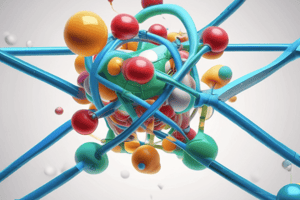Podcast
Questions and Answers
What conclusion did he reach about the mass gained by the tree?
What conclusion did he reach about the mass gained by the tree?
- The mass gained came from the air.
- The mass gained came equally from water and soil.
- The mass gained came from the soil.
- The mass gained came from the water. (correct)
According to the law of definite proportions, what is the mass ratio of oxygen to hydrogen in water?
According to the law of definite proportions, what is the mass ratio of oxygen to hydrogen in water?
- 1 to 8
- 4 to 1
- 2 to 1
- 8 to 1 (correct)
If there are 16.89 g of magnesium in a sample of MgO, how much oxygen is present?
If there are 16.89 g of magnesium in a sample of MgO, how much oxygen is present?
- 8.12 g
- 11.11 g (correct)
- 14.78 g
- 19.00 g
What aspect of matter does Dalton’s atomic theory NOT emphasize?
What aspect of matter does Dalton’s atomic theory NOT emphasize?
What does the law of multiple proportions indicate about different compounds of the same elements?
What does the law of multiple proportions indicate about different compounds of the same elements?
Which of the following compounds contains the highest mass of oxygen per atom of carbon?
Which of the following compounds contains the highest mass of oxygen per atom of carbon?
In the formation of nitrogen oxides, what weight of nitrogen combines with 48 g of oxygen?
In the formation of nitrogen oxides, what weight of nitrogen combines with 48 g of oxygen?
What is NOT a component of Dalton's atomic theory?
What is NOT a component of Dalton's atomic theory?
Which particle has a positive charge and is located in the nucleus of an atom?
Which particle has a positive charge and is located in the nucleus of an atom?
How does the mass of an electron compare to that of a proton?
How does the mass of an electron compare to that of a proton?
What is the mass number (A) of an atom if it has 6 protons and 8 neutrons?
What is the mass number (A) of an atom if it has 6 protons and 8 neutrons?
What effect does gaining an electron have on an atom?
What effect does gaining an electron have on an atom?
Which statement about anions is correct?
Which statement about anions is correct?
What determines the charge of an atom?
What determines the charge of an atom?
What is the atomic number (Z) of an element?
What is the atomic number (Z) of an element?
What type of ion is Mg2+?
What type of ion is Mg2+?
What do condensed structural formulas represent?
What do condensed structural formulas represent?
In line-angle formulas, what does an end or intersection of a line typically represent?
In line-angle formulas, what does an end or intersection of a line typically represent?
How are elements arranged in the Modern Periodic Table?
How are elements arranged in the Modern Periodic Table?
What is indicated by the group number in relation to valence electrons?
What is indicated by the group number in relation to valence electrons?
What is a characteristic of elements within the same group of the Periodic Table?
What is a characteristic of elements within the same group of the Periodic Table?
What is the charge of the magnesium ion represented as Mg2+?
What is the charge of the magnesium ion represented as Mg2+?
How many protons are present in a Mg2+ ion?
How many protons are present in a Mg2+ ion?
Which of the following statements about ionic compounds is true?
Which of the following statements about ionic compounds is true?
Which of the following represents an empirical formula?
Which of the following represents an empirical formula?
What distinguishes molecular compounds from ionic compounds?
What distinguishes molecular compounds from ionic compounds?
Which of the following refers to the true number of atoms in a molecule?
Which of the following refers to the true number of atoms in a molecule?
What happens during the formation of an ionic bond?
What happens during the formation of an ionic bond?
How many electrons does a Mg2+ ion possess?
How many electrons does a Mg2+ ion possess?
What is the correct name for the compound FeO?
What is the correct name for the compound FeO?
Which of the following correctly represents the formula for copper(II) chloride?
Which of the following correctly represents the formula for copper(II) chloride?
What is the charge of the ammonium ion?
What is the charge of the ammonium ion?
Which of the following names corresponds to the ion with the formula CrO4^2-?
Which of the following names corresponds to the ion with the formula CrO4^2-?
How should the compound P2O5 be named?
How should the compound P2O5 be named?
What is the correct name for the ion SO4^2-?
What is the correct name for the ion SO4^2-?
What prefix is used to denote three atoms in a compound's name?
What prefix is used to denote three atoms in a compound's name?
Which of the following is the correct formula for the hypobromite ion?
Which of the following is the correct formula for the hypobromite ion?
Flashcards are hidden until you start studying
Study Notes
The Law of Definite Proportions
- In a chemical compound, the elements are always combined in the same proportions by mass.
- For example, water is always composed of 8 parts by mass of oxygen and 1 part by mass of hydrogen.
Dalton’s Atomic Theory
- Proposed in 1803 to explain the law of conservation of mass and the law of definite proportions.
- Matter is composed of atoms, which are tiny, indivisible particles.
- All atoms of a given element are the same, but differ from atoms of other elements.
- Compounds are formed when atoms of different elements unite in fixed proportions.
- Chemical reactions involve the rearrangement of atoms, no atoms are created, destroyed, or broken apart.
The Law of Multiple Proportions
- When two or more compounds of the same two elements are compared, the masses of one element that combine with a fixed mass of the second element are in the ratio of small whole numbers.
- Example:
- In Carbon monoxide (CO), 12.0 g of carbon combines with 16.0 g of oxygen.
- In Carbon dioxide (CO2), 12.0 g of carbon combines with 32.0 g of oxygen.
- The ratio of oxygen/carbon in these two compounds is 1:2.
The Modern View of Atomic Structure
- The atom has a structure that includes a nucleus and an electron cloud.
- The nucleus contains protons and neutrons:
- Protons carry a positive charge.
- Neutrons carry no charge.
- The electron cloud contains negatively charged electrons.
- Protons and neutrons are much heavier than electrons.
Atomic Notation
- Atomic number (Z) is the number of protons in an atom.
- Mass number (A) is the sum of protons and neutrons in an atom.
- Charge (q) is the difference between protons and electrons (protons - electrons).
- The symbol for an element is written as: ^A_ZQ where Z is the atomic number, A is the mass number, and Q is the charge.
Ions
- An anion is a negatively charged ion formed when an atom gains electrons.
- A cation is a positively charged ion formed when an atom loses electrons.
Molecules and Ions
- Molecular compounds involve shared electrons and consist of electrically neutral, discrete particles (molecules).
- Ionic compounds involve electron transfer between metals and nonmetals and consist of charged particles (ions).
Chemical Bonds
- Covalent bonds involve shared electrons between atoms.
- Ionic bonds involve the complete transfer of electrons from one atom to another.
Types of Formulas
- Empirical formulas represent the lowest whole number ratio of atoms in a compound.
- Molecular formulas show the true number of atoms of each element in the formula of a compound.
- Structural formulas show how atoms are attached together and the order in which atoms are bonded.
The Periodic Table
- Organizes elements based on increasing atomic number.
- Rows are called periods.
- Columns are called groups or families.
- Elements within a group share similar properties due to similar valence electron configurations.
Naming Compounds
- For ionic compounds:
- Name the cation.
- Indicate the charge of the cation using Roman numerals in parentheses.
- Name the anion.
- For covalent compounds:
- Use prefixes (mono, di, tri, etc.) to indicate the number of atoms of each element.
- Name the second element using the suffix "-ide".
Identifying Empirical Formulas
- An empirical formula represents the simplest whole number ratio of atoms in a compound.
- Divide all subscripts in a molecular formula by the greatest common factor to get its empirical formula.
Polyatomic Ions
- Consist of multiple atoms with a net charge.
- Have specific names that need to be memorized.
- Some polyatomic ion names change based on the number of oxygen atoms present.
- Use prefixes like "per-", "hypo-", and "-ite" or "-ate" to denote changes in the number of oxygen atoms within the ion.
Studying That Suits You
Use AI to generate personalized quizzes and flashcards to suit your learning preferences.




